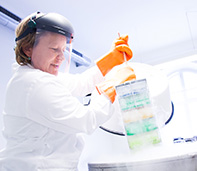DNA and tissue collections
The Natural History Museum of Denmark has been selected as the national repository for DNA and tissue samples. All DNA and tissue samples from Denmark, Greenland and the Faeroe Islands are deposited here alongside samples collected abroad by Danish researchers.
For more than 25 years the Natural History Museum of Denmark has collected DNA and tissue samples of more than 25,000 species of plants and animals. The primary purpose is to secure the samples in order to document biological diversity. The museum also encourages the use of the samples in international not-for-profit experiments, studies of phylogeny and medicinal research.

DNA og tissue samples are kept in liquid nitrogen at temperatures below minus 150 °C (Photo: Lennart Søgård-Høyer)
The DNA and tissue collections of the Natural History Museum of Denmark are part of an international network of DNA and tissue repositories, whose purpose it is to collect and preserve samples from a selection of Earth’s many millions of species.
DNA and tissue collections contain samples of tissue or blood from plants or animals. The samples are either preserved in frozen form or a grown as new plant tissue in artificial environments. In this way, the genetic content of the samples can be maintained for very long timespans, partly as documents of biological diversity, partly to secure the material for future researchers.
Tissue and DNA is often expensive, time-consuming and difficult to collect, as samples must be made through specific methods, and often in a natural environment. The methods have been developed to avoid sample contamination with “outside” DNA and to ensure their intactness, until they can be included in a secure DNA and tissue repository.
The National DNA and Tissue Repository
The DNA and tissue samples of the museum a kept in the National DNA and Tissue Repository. The purpose of the repository is to maintain samples from Denmark, Greenland and the Faeroe Islands together with samples collected abroad, which have been used in studies by Danish researchers.
Through the repository, Denmark is part of an international network of DNA and tissue repositories, which delegates the work of collecting and preserving samples from the millions of species on our planet.
Botany
The botanical tissue repositories of the Natural History Museum of Denmark encompasses a cryogenic gene bank and a seed gene bank.
The seed gene bank contains seeds from around 800 wild Danish species, 1,000 species from the Botanical Gardens collections and 150 lots of seeds of special relevance to research.
Zoology
The Natural History Museum of Denmark maintains one of the largest collections of DNA and tissue from birds in the world. More than 3,500 species are represented, predominantly as blood samples in a cryogenic collection. The collection also encompasses numerous samples of African reptiles and mammals, as well as a smaller number of arthropods. Future arrangements have been made for the inclusion of prehistoric DNA samples of mammoths and woolly rhinoceroses.
